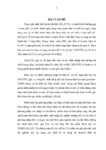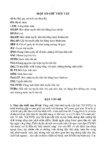
Please use this identifier to cite or link to this item:
http://dulieuso.hmu.edu.vn/handle/hmu/1693| Title: | Nghiên cứu hiệu quả điều trị tăng sinh lành tính tuyến tiền liệt bằng kỹ thuật laser phóng bên |
| Authors: | Nguyễn Viết, Thành |
| Advisor: | PGS.TS. Đỗ Thị Khánh, Hỷ GS.TS. Phạm, Thắng |
| Keywords: | 62720146;Nội thận - Tiết niệu |
| Issue Date: | 2017 |
| Abstract: | TRANG THÔNG TIN VỀ NHỮNG ĐÓNG GÓP MỚI CỦA LUẬN ÁN. Tên đề tài luận án: Nghiên cứu hiệu quả điều trị tăng sinh lành tính tuyến tiền liệt bằng kỹ thuật laser phóng bên. Chuyên ngành: Nội thận-Tiết niệu. Mã số: 62720146. Họ và tên nghiên cứu sinh: Nguyễn Viết Thành. Họ và tên Người hướng dẫn: 1. PGS.TS Đỗ Thị Khánh Hỷ. 2. GS.TS Phạm Thắng. Cơ sở đào tạo: Trường Đại học Y Hà Nội. Tóm tắt những đóng góp mới của luận án: . Kỹ thuật laser phóng bên sử dụng nguồn laser diode bước sóng 980nm gây bay hơi tuyến tiền liệt để điều trị bệnh tăng sinh lành tính tuyến tiền liệt lần đầu tiên được triển khai tại Việt Nam với các đặc điểm:. - Có thể tiến hành an toàn trên những đối tượng bệnh nhân tuổi cao và rất cao, có nhiều bệnh mắc kèm gây ra nguy cơ cao trong can thiệp tuyến tiền liệt.. - Thời gian lưu ống thông niệu đạo sau khi can thiệp ngắn (trung bình 25h), giúp giảm thời gian khó chịu cho bệnh nhân và giảm thời gian nằm viện.. - Cầm máu tốt và sử dụng dung dịch huyết thanh mặn đẳng trương làm dung dịch nội soi nên giảm nguy cơ chảy máu, giảm nguy cơ gây hội chứng nội soi.. - Có hiệu quả trong điều trị bệnh tăng sinh lành tính tuyến tiền liệt: giảm điểm số thang điểm IPSS từ trước điều trị 28,75 điểm giảm xuống còn 4,66 điểm, thang điểm chất lượng sống trước điều trị 4,8 điểm giảm xuống còn 1,97 điểm. Giảm thể tích nước tiểu tồn dư từ trước điều trị 50,29cm3 xuống 5,5 cm3, giảm thể tích tuyến tiền liệt 56% tại thời điểm sau điều trị 12 tháng. Tăng lưu lượng đỉnh dòng tiểu từ 6,82 ml/s lên 15,39ml/s. 95,3% bệnh nhân đạt kết quả điều trị tốt và khá trong đó kết quả tốt là 81,3%.. - Kỹ thuật laser phóng bên diode 980nm gây bay hơi tuyến tiền liệt ít gây các tai biến nghiêm trọng trong và sau điều trị. Các khó chịu hay gặp trong điều trị gồm kích thích niệu đạo trong thời gian lưu ống thông niệu đạo, đái gấp sau rút xông tiểu trong vài ngày, đái máu mức độ nhẹ vài giọt đầu bãi, nhiễm trùng tiết niệu mức độ nhẹ được khống chế bằng thuốc. Không có bệnh nhân nào bị hội chứng nội soi . Không có bệnh nhân nào tử vong. Ít ảnh hưởng đến chức năng sinh dục của bệnh nhân.. - Có thể ứng dụng kỹ thuật này trong điều trị bệnh xơ hẹp cổ bàng quang.. - Góp thêm một lựa chọn điều trị cho bệnh nhân tăng sinh lành tính tuyến tiền liệt, nhất là những đối tượng có nguy cơ tử vong cao trong phẫu thuật. Cán bộ hướng dẫn (Ký và ghi rõ họ tên) Hà Nội, ngày 9 tháng 5 năm 2017 Nghiên cứu sinh (Ký và ghi rõ họ tên) PGS.TS. Đỗ Thị Khánh Hỷ Nguyễn Viết Thành THE INFORMATION ON THE NEW CONTRIBUTIONS OF THE THESIS. Thesis title: The study of the effectiveness of treatment of benign prostatic hyperplasia by side-firing laser technique . Specialization: Internal Medicine of Kidney - Urology. Code: 62720146. Full name of the instructor teacher:. 1. A/Prof. MD. PhD. Do Thi Khanh Hy2. Prof. MD. PhD. Pham Thang. Training facility: Hanoi Medical University. The 980-nm diode laser vaporization technique was first introduced in Vietnam to treat benign prostate hyperplasia. The procedure has following characteristics:. - It can be safely performed in elderly patients who usually have multiple disorders carrying high risk of surgery related mortality.. - Transurethral catheterization time was reduced to average of 25 hours, resulting in shorter hospital stay and patients’ discomfort.. - Good haemostatic ability and the use of normal saline solution during the procedure reduced the risk of haemorrhage and transurethral resection syndrome.. - The efficacy of procedure in the treatment of benign prostatic hyperplasia includes: The international prostate symptom score (IPSS) improved from 28.75 at baseline to 4.66 at 12 months postoperatively. The quality of life score (QoL) reduced from 4.8 at baseline to 1.97 at 12 months postoperatively. Post void residual volume reduced from 50.29 ml at baseline to 3.5ml at 12 months postoperatively. Prostate volume reduced by 56% at 12 months postoperatively. The maximum urine flow rate (Qmax) increased from 6.82ml/s at baseline to 15.39 ml/s at 12 months after operation. Overall good and fair outcome was 95.3%.. - The complications during and after surgery are less serious, including irritation of urethra during urethral catheterization, urgent voiding, mild haematuria, urinary tract infection at 1-2 weeks after catheter removal controllable by drug. No case of mortality and transurethral resection syndrome were seen. Less impact on erectile dysfunction was recorded.. - The procedure can be used to treat bladder neck contractures.. - The procedure offers an additional safe treatment option for patients with benign prostatic hyperplasia, especially patients with high risk of surgery related mortality Signature of the instructor teacher Hanoi, 9 May, 2017 Signature of the doctoral student Do Thi Khanh Hy Nguyen Viet Thanh . |
| URI: | http://dulieuso.hmu.edu.vn//handle/hmu/1693 |
| Appears in Collections: | Luận án (nghiên cứu sinh) |
Files in This Item:
| File | Description | Size | Format | |
|---|---|---|---|---|
| 251_NGUYENVIETTHANH-LA.pdf Restricted Access | 2.4 MB | Adobe PDF |  Sign in to read | |
| 251_NguyenVietThanh-tt.pdf Restricted Access | 1.51 MB | Adobe PDF |  Sign in to read |
Items in DSpace are protected by copyright, with all rights reserved, unless otherwise indicated.